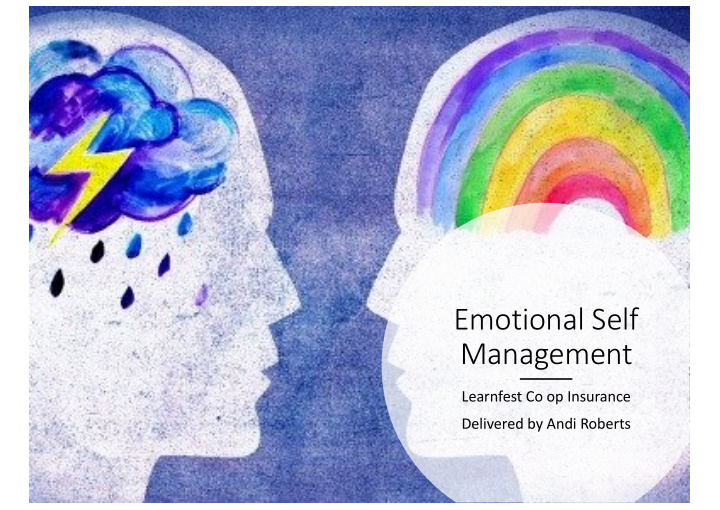



Emotional Self Management Learnfest Co op Insurance Delivered by Andi Roberts
• Quickly review Goleman model of emotional intelligence • Understand why emotional self management is so important Goals of • Learn two ways of better session understanding our emotions • Learn two ways to manage your emotions • Handouts at http://bit.ly/coopfest Artist: Shin Kwang Ho
Why emotional self management • “T he core of high EI is self-awareness: if you don't understand your own motivations and behaviors, it's nearly impossible to develop an understanding of others. A lack of self-awareness can also thwart your ability to think rationally and apply technical capabilities.” Daniel Goleman • “ EQ has twice the power of iQ to predict performance. EQ is also a better predictor than employee skill, knowledge, or expertise ” EI Consortium • 75 percent of careers are derailed for reasons related to emotional competencies, including inability to handle interpersonal problems; unsatisfactory team leadership during times of difficulty or conflict; or inability to adapt to change or elicit trust. - Center for Creative Leadership Artist: Shin Kwang Ho
Em Emotional al Intel elligen ence e simplified ed MANAGE WORK WITH SELF OTHERS KNOW KNOW SELF OTHERS Based on work by D Goleman Artist: Stephen K
How many emotions do we have?
5,8,27 or more Think about: Name Source Level
2 - Tools for raising awareness
1 - Energy chart Choose a time period: Meeting. Day, Project, Week, Month, year etc Positive energy / emotions Reflect on inflection points Causes, emotions, impact AND how you could handle them differently Negative energy / emotions Based on work by R Greenaway
Energy chart Choose a time period: Meeting. Day, Project, Week, Month, year etc Positive energy / emotions Reflect on inflection points “ There is nothing either Causes, emotions, impact good or bad, but thinking AND how you could handle makes it so ” them differently Hamlet – W Shakespeare Negative energy / emotions Based on work by R Greenaway
2 - eMap à Emotional Map (Russell 1980) (Cope 2004)
eMap à Emotional Map What impact the emotion has Unpleasant Pleasant (Russell 1980) (Cope 2004)
eMap à Emotional Map High energy What level of intensity or energy the emotion has Low energy (Russell 1980) (Cope 2004)
eMap à Emotional Map High energy Unpleasant Pleasant “Stressed” “Stimulated” “Sad” “Serene” Low energy (Russell 1980) (Cope 2004)
High energy “Stressed” “Stimulated” Anger Excitement Anxiety Astonishment Fear Joy Unpleasant Disgust Love Pleasant Hate Surprise Desperation Arousal Boredom Blissfulness Irritation Contentment Unhappiness Gladness Loneliness Happiness Resignation Hope Guilt Relaxation Pride “Sad” “Serene” Low energy (Russell 1980) (Cope 2004)
High energy “Stressed” “Stimulated” 5 X) Event & Feeling & Cause Unpleasant Pleasant 6 4 Y) Event & Feeling & Cause 3 2 Z) Event & 7 8 Feeling & Cause 9 1 “Sad” “Serene” Low energy (Russell 1980) (Cope 2004)
Activity - Apply one of the two tools on yourself (pick an appropriate time frame) – Draw and reflect Artist: Cameron Grey
3 – Approaches to manage emotions
1 - Remove emotional hijacking STOP BREATHE REFOCUS CHOOSE
2 – ABCDE by Albert Ellis
2 – ABCDE by Albert Ellis • Empirical / Scientific dispute – Where is the proof or basis for the belief / feelings / thought pattern • Functional dispute – Is the belief supporting some other, potentially unconscious goals? • Logical dispute – Does the belief system make common sense? Is there any generalization or other thought pattern influencing these beliefs?
Activity – Where, When and how could you use these two ideas? Discuss OR share in chat!
Throw into chat (A) Your key insight (B) One thing you will do after today’s sessions
Emotional Self Management Many thanks! Andi Roberts Learnfest Co op Insurance @andi_Roberts linkedin.com/in/andiroberts/
Recommend
More recommend